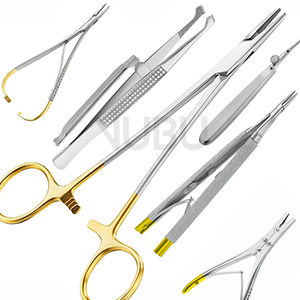Our special surgical suture instruments, such as needle holders, are available in two different versions, meeting the highest quality standards and catering to the demands of modern surgical procedures. Whether for routine operations or complex interventions, our instruments are designed to provide optimal support to surgeons.
Standard Needle Holders: Robust and Reliable
The standard version of our needle holders is made entirely from medical-grade steel. This material ensures excellent clamping functionality of the needle, enabling superior needle control. These needle holders are ideal for a wide range of surgical applications and deliver reliable performance with every use.
Needle Holders with Tungsten Carbide Inserts: Maximum Durability and Precision
Needle holders are subjected to significant stress during use, which can lead to a loss of grip in the jaws over time. To address this issue, we offer needle holders with tungsten carbide inserts in the jaw. The grip of these instruments is particularly resistant to wear and provides excellent fixation of the clamped needle. This version can be recognized by its gold-plated handle, which not only looks appealing but also signifies top-tier quality.
Micro Needle Holders: Precision for Delicate Work
For particularly fine and demanding procedures, such as those required in microsurgery or ophthalmology, we offer micro needle holders and TC micro needle holders. These instruments feature a special spring tension system that ensures precise and controlled needle handling. They are ideal for surgeries where the highest level of accuracy is essential.
TC Wire Cutters with Tungsten Carbide: Versatility and Strength
Our product range also includes TC wire cutters with tungsten carbide, designed for use with various wire thicknesses. Here, too, only the finest tungsten carbide is used to ensure long-lasting durability and reliable performance. These cutters are indispensable for orthopedic and trauma surgeries.
Comprehensive Range of Suture Instruments
In addition to needle holders and wire cutters, our category of suture instruments also includes:
Guide probes: For precise guidance and placement of sutures.
Suture retrievers: For easy grasping and handling of sutures.
Reverdin Needles: Ideal for specialized suturing techniques.
Ligature needles: For secure ligation of vessels.
Wound clip applicators and forceps: For quick and efficient wound closure.
Innovations in Surgical Instrument Technology
Our instruments are characterized by innovative features, such as:
Ergonomic handles: For comfortable handling and reduced fatigue during lengthy procedures.
High-quality materials: For maximum durability and safety.
Precision-engineered components: For accurate and reliable performance.
Conclusion
Our surgical suture instruments are designed to support surgeons at every stage of a procedure. Combining high-quality materials, innovative designs, and precise craftsmanship, we offer instruments that meet the highest standards. Explore our extensive range and benefit from products that combine precision, durability, and user-friendliness.
Suturing is a central component of medical practice, where tissue is joined using needles and threads to close wounds. Proper suturing technique is crucial for quick and complication-free healing, as it ensures that the wound layers lie together without tension. This technique is supported by a variety of suture materials and needle holders, which enable surgeons to meet the specific requirements of different surgical procedures.
The Importance of Suturing Technique
Precise suturing is not only essential for wound healing but also for the aesthetic outcome. By choosing the right suture materials and instruments, surgeons can ensure that the wound is securely closed, minimizing the risk of infections, scarring, or wound dehiscence (separation of wound edges). Needle holders play a critical role in this process, as they allow for precise needle control and ensure accurate stitches.
Historical Development of Suture Materials
In the past, natural materials such as silk and catgut were used as suture materials. However, these materials had several disadvantages, including limited durability and a higher risk of allergic reactions. Today, modern synthetic materials are almost exclusively used, offering greater biocompatibility and better mechanical properties.
Absorbable and Non-Absorbable Sutures
Modern suture materials are divided into two main categories:
Absorbable Sutures: These sutures are broken down by the body and do not need to be removed. They are particularly suitable for internal sutures, where later removal is not possible or practical.
Non-Absorbable Sutures: These sutures must be removed after a certain period, as they can cause inflammation or foreign body reactions if left in place. They are often used for skin sutures or in areas subjected to high mechanical stress.
Factors in Choosing Suture Materials
The choice of the right suture material depends on various factors, including:
Absorption Time: The time it takes for the body to break down the suture.
Dissolution Time: The time until the suture is completely dissolved.
Tissue Type: Different tissues require different sutures. For example, skin, muscles, or organs need specific materials.
Mechanical Stress: Sutures must withstand the stress they are exposed to in the body.
Modern Suture Materials and Their Degradation
Today’s sutures are typically degraded hydrolytically by bodily fluids. The size of the suture surface and the type of tissue being sutured play an important role in this process. Modern materials such as polyglycolic acid (PGA), polydioxanone (PDS), or polyglactin (Vicryl) offer an excellent balance between strength and absorbability.
The Role of Needle Holders in Surgical Practice
Needle holders are indispensable tools in surgical practice. They enable surgeons to guide the needle precisely and place accurate stitches. Our needle holders are available in various designs, including:
Standard Needle Holders: Made from medical-grade steel for reliable clamping functionality.
Needle Holders with Tungsten Carbide Inserts: For particularly durable jaws and extended longevity.
Micro Needle Holders: For delicate work in microsurgery or ophthalmology.
Conclusion
Surgical wound care is a complex process that requires precision, expertise, and high-quality instruments. By choosing the right suture materials and needle holders, surgeons can achieve optimal outcomes and promote patient healing. Our products are designed to offer the highest quality and user-friendliness, supporting you at every step. Explore our extensive range and benefit from innovative solutions that make your work easier.
